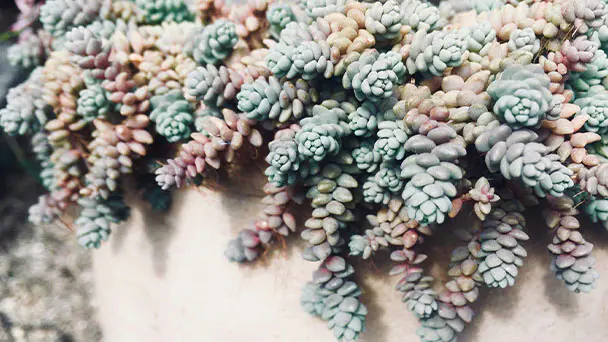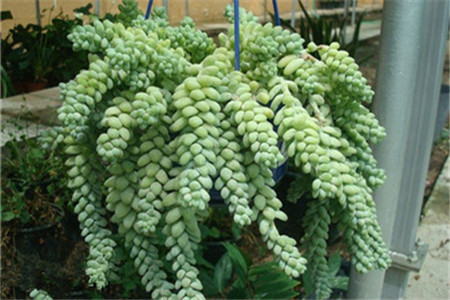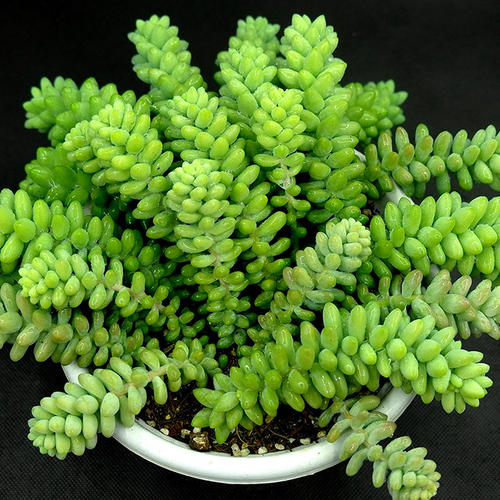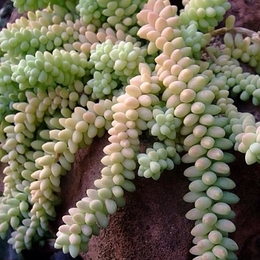Burros Tail (Sedum Morganianum) Profile
Written by Maggie
Dec 09 2022

Burro's Tail, scientific name Sedum burrito Moran, is a member of the Sedum genus (Pterocarpa) in the Sedum family, native to Mexico. Burro's Tail leaf blade is not curved, circular tip, length about 1.5 cm.
Burro's Tail Picture

Burro's Tail Quick Info
| Botanical/Scientific Name | Sedum Morganianum |
| Common Name | Burro's Tail |
| Uses | Easy-care house plant |
| Origin | Southern Mexico and Honduras |
| Light Care | Bright light of four hours |
| Soil Care | Moist soil |
| Temperature Care | 65 degrees Fahrenheit to 75 degrees Fahrenheit |
| Humidity Care | Moist |
| Watering | Don't water it more than once a month |
| Pruning Care | Prune every 2-3 years |
| Fertilizer Care | Fertilizer two or three times through spring and summer |
| Propagation | Stem cuttings |
| Toxic | Non-toxic to cats and dogs |
| Flower Color | Showy pink to red blossoms |
When to Plant Burro's Tail
Generally speaking, burro's tail sowing is mostly carried out in spring and autumn. The reason why these two seasons are suitable is that the best sowing temperature of the burro's tail is between 20 ℃ and 25 ℃. If the temperature is too high, burro's tail seeds are easy to rot, and even if they germinate, the seedlings can easily turn into water.Morphological characteristics of Burro's Tail
Burro's Tail (Sedum burrito Moran) leaves are not curved, the end of the leaves is round, about 1.5 cm, a little like rice grain, and the surface range of each grain is basically without twists and turns. The Burro's Tail leaf surface has a thin layer of white powder, watering should be poured on the soil, try not to water its leaves, as the white powder easy to fall off because of watering, and touch. Leaves will not open in flower shape, do not go to pull the leaves, and it is easy to fall, a little force will fall. The leaves grow in one long line, and the leaf wraps around the branch in a spiral.
Burro's Tail Distribution Range
Burro's Tail is native to Mexico. It has round uncurved leaves about 1.5 cm in length. Burro's Tail can be grown by strolling or hanging.
Ecological habits of Burro's Tail
Burro's Tail plants grow prostrate or suspended. The dense leaves grow in bright light and are attractive. If left in a low-light place for too long, they will grow barren. Burro's Tail generally thrives on sunlight, whether half or full, except in the hot summer midday glare. Burro's Tail is drought-tolerant and prefers well-drained soil.

Burro's Tail Care in Detail
Burro's Tail Light
Burro's tail, like Donkey Tail and other succulent plants, needs sunshine to the importance of slightly shading, just like the temperature near the sunny window is very suitable. (Read more about Burros Tail VS Donkey Tail.)Read Next: How Much Light Does Burros Tail Need?
Burro's Tail Humidity
Because the fleshy leaves of burro's tail can store water and are very drought resistant, we only need to be able to maintain the moisture of burro's tail basin soil during the growth period. In winter, the growth is relatively slow and the number of watering needs to be reduced.Read More:
How to grow and care for Burros Tail
Burro's Tail Pruning
Generally, we don't use scissors to trim burro's tail. Generally, the overgrown burro's tail is thick and lignified. If we use scissors to trim burro's tail, it is easy to damage plant tissue.Don't touch anything on the trimmed burro's tail wound, especially when watering, don't let the water drench the wound and wait for the wound to heal.
When pruning burro's tail, we must fix the stem of the jade bead curtain and do not shake it to avoid hurting ourselves.
Burro's tail is very drought resistant, and it doesn't matter if you don't water it for a long time, so it doesn't need to be watered whether burro's tail is trimmed or not.
Burro's Tail Repotting
Burro's tail repotting must be carried out in spring. Because succulent plants like a well-drained growth environment, the soil for burro's tail should be sandy soil with good drainage and rich in organic matter, such as culture soil gently composed of river sand, snake sawdust and vermiculite.Burro's Tail Soil
Burro's Tail is relatively drought-tolerant. Like other succulents in the family, Burro's Tail likes well-drained soil. If the soil is poorly drained, it can easily cause root rot due to water accumulation in the pot soil.Burro's Tail Fertilizer
Although Burro's Tail is a leaf-watching succulent, it is not suitable for nitrogen fertilizer, because nitrogen can cause them to absorb too much water, so that the stems and leaves become fragile because they store too much water. They are more likely to break or drop leaves.
Burro's Tail Temperature
When the temperature is higher than 33℃, Burro's Tail will go into hibernation and stop growing. If the temperature is close to 0℃, Burro's Tail will freeze to death. In summer, proper shade is needed. Leaves grow denser under bright light, which makes them look better. If left in a low-light place for too long, they will grow empty.
Burro's Tail Watering
In Burro's Tail dormant period and winter low-temperature days to reduce watering, on the contrary, summer will slightly increase the number of watering to aviod underwatered Burro's Tail. We should cool them down, and avoid watering at noon under the strong light. Watering Burros Tail should also be poured on the soil, as far as possible not to water its leaves, because the leaves have thin white powder easy to fall off because of watering, touch. (Read more about saving Overwatered Burros Tail.)
Burro's Tail Propagation Methods
We can fall down Burro's Tail leaf to propagation again, regard it as the seed is equally scattered inside the basin, do not water first next, wait for leaf after hair root just water, then hang it in the balcony sunshine sufficient not to drain the place. The medium is dry, just water, fertilized every season to apply, applying fertilizer quantity cannot be overmuch. (Read more about How To Propagate Burro's Tail.)

Burro's Tail Propagation from Cutting
In fact, burro's tail multi flowerpots are not particular. In fact, we only need to buy some large shallow flowerpots. For basin soil, we'd better choose some fertile, loose and breathable rotten leaf soil, and then mix some small white broken stones.
Generally, we can put three-quarters of the prepared rotten leaf soil into burro's tail flower pot, then pour it with water, and spread the remaining flower soil on it. In this way, the prepared pot soil will not be too dry or too wet, which is very good for burro's tail propagation from cutting.
After the basin soil is prepared, the prepared burro's tail blades are placed on the prepared basin soil, and then placed in a cool and ventilated place for maintenance. Generally, it is better to wait for three weeks.
In the process of waiting, we also need careful maintenance, especially in terms of watering. In the process of maintenance, we must keep the basin soil moist. If the soil is dry, we can water from the edge of the flower pot. And don't often turn the blade with your hand.
Burro's Tail Propagation from Seed
Burro's tail propagation from seed can be sown in the growing season (autumn is the best, followed by spring). The sowing temperature is generally controlled at 18-23 degrees. A portion of peat + vermiculite + perlite can be used as the soil for sowing. After soaking with insecticidal and bactericidal water, the seeds can be sown flat on the soil surface and covered with film (breathable for 2 hours every day). Generally, they sprout in about a week, and the film can be removed after they sprout neatly, Increase illumination.
How to Deal with Curly Leaves & Burros Tail Shriveling?
Burro's tail leaves have shrunk for two reasons. First, the light is too strong. Although it likes light, if it is placed in a place with strong light for a long time, it is easy to be burned, and the leaves will dry and shrink. It should be noted that the strong light must be covered in time and not exposed to the sun. It may also be lack of water, the soil is too dry, the plants can not absorb the due water, and the leaves will shrink. We should replenish water appropriately and pay attention not to ponding. (Read more about Burros Tail Shriveling.)
Why Do My Burro's Tail Yellow Leaves Fall?
Burro's tail likes a warm growth environment. It's best to keep the temperature between 16 ℃ and 28 ℃ during maintenance. If the temperature exceeds 35 ℃ in summer, we need to spray water to cool the burro's tail, otherwise yellow leaves will fall. In winter, the temperature needs to be kept above 5 ℃. If the temperature is lower than 5 ℃, the jade bead curtain will be frostbitten, A condition that causes yellow leaves to fall. (Read more about saving Burros Tail Leaves Falling Off.)
Avoid Exposure to the Sun
Burro's tail prefers sunshine. During the maintenance period, the time of receiving light every day should not be less than 2 hours, otherwise, the burro's tail will fall yellow leaves due to lack of light. However, the burro's tail is very afraid of strong light, so we should shade the burro's tail in summer when the light is strong, otherwise, burro's tail will be sunburned, resulting in yellow leaves falling.
Reasonable Watering
Burro's tail likes a dry growth environment and is very afraid of ponding, so we don't water the jade bead curtain frequently when maintaining it. If too much watering causes ponding, the jade bead curtain will rot and cause the yellow leaves of the burro's tail to fall. At this time, we should drain the ponding in time, and then strengthen ventilation to let the water in the soil evaporate quickly.
Latest Updated
- Benefits of Bugleweed - 7 Science-backed Health Benefits
- Bugleweed Dangers & Side Effects - Is It Poisonous?
- How to Plant Evergreen Trees - What You Should Know
- When to Plant Evergreens - Grow Guide for Evergreen Trees
- 12 Wonderful Evergreen Shrubs for Your Garden
- 12 Popular Evergreen Plants with Pictures for Beginners
- When And How To Prune A Lilac Bush Like a Pro
- How to Grow & Care for Lilac Vine (Hardenbergia Violacea)
- Japanese Lilac Tree (Syringa Reticulata) Care & Propagation Guide
- Shumard Oak Pros and Cons - What to Know
Popular Articles
- Winter maintenance of Antirrhinum Majus
- How to Grow Terminalia Mantaly Tree
- How to Grow and Care for Crossostephium Chinense
- How to grow Antirrhinum Majus in spring
- Peristeria Elata (Dove Orchid) Profile: Info & Care Guide
- Underwatered Snake Plant (Sansevieria Trifasciata) - Signs And How To Fix
- How to Care for Brazilian Jasmine Plant (Mandevilla Sanderi)
- How to Grow & Care for Graptopetalum Purple Delight in Summer
- Rosa Chinensis (China Rose): Plant Growing & Care Tips
- How to Care for Baby Sun Rose (Aptenia Cordifolia)